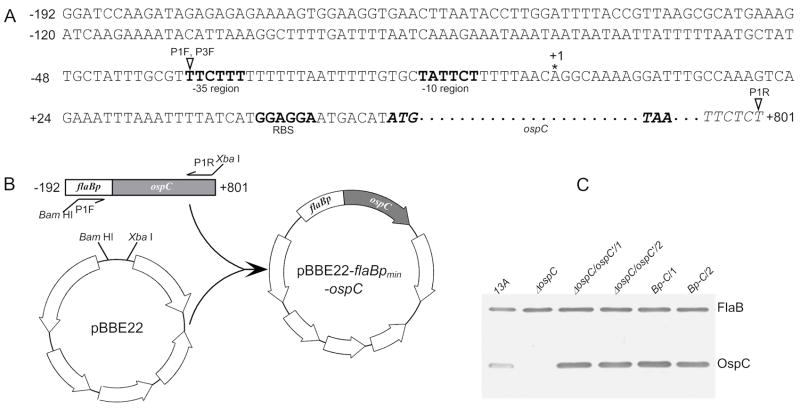Fig. 1.
Identification of a minimum flaB promoter. (A) Extended flaB promoter sequence and fused promoterless ospC gene. This sequence is already in pBBE22-ospC′, which was constructed from pBBE22 in our previous study [20]. The sequence includes the flaB promoter and upstream sequence, extending to −192 from its transcriptional start site, and a promoterless ospC gene (italic), extending from the start codon ATG (boldface) to +801 from the transcriptional start site of the ospC gene. The stop codon TAA (boldface) of ospC is also present. The −35 and −10 regions, and the putative ribosome-binding site (RBS) (all in boldface type) of the flaB gene are indicated. The asterisk marks the previously identified transcriptional initiation site [44]. The amplification start sites of primers, P1F, P3F and P1R, are pointed with open triangles. P1F and P3F had an identical sequence, but were incorporated with different restriction enzyme sites, and were used for plasmid construction described in this figure and Fig. 3, respectively. (B) Construction of pBBE22-flaBpmin-ospC from pBBE22 and pBBE22-ospC′. An 883-bp fragment was PCR amplified with the use of primers P1F and P1R, and of pBBE22-ospC′ as a template, then cloned into pBBE22. (C) Immunoblot analysis of OspC expression. The parental clone 13A, the ospC mutant (ΔospC), and the clones ΔospC/ospC′/1, ΔospC/ospC′/2, Bp-C/1 and Bp-C/2 were verified for OspC expression by immunoblotting probed with a mixture of FlaB and OspC MAbs.

